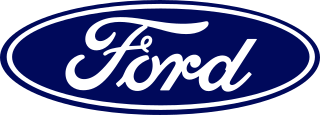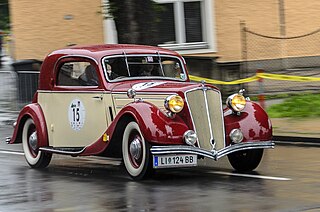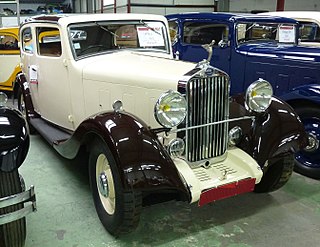
Simca was a French automaker, founded in November 1934 by Fiat S.p.A. and directed from July 1935 to May 1963 by Italian Henri Pigozzi. Simca was affiliated with Fiat and, after Simca bought Ford's French subsidiary, became increasingly controlled by Chrysler. In 1970, Simca became a brand of Chrysler's European business, ending its period as an independent company. Simca disappeared in 1978, when Chrysler divested its European operations to another French automaker, PSA Peugeot Citroën. PSA replaced the Simca brand with Talbot after a short period when some models were badged as Simca-Talbots.

Mathis S.A. was an automobile manufacturer in Alsace that produced cars between 1910 and 1950. Founder Émile Mathis (1880–1956) was born in Strasbourg and died in Geneva.

Unic was a French manufacturer founded in 1905, and active as an automobile producer until July 1938. After this the company continued to produce commercial vehicles, retaining its independence for a further fourteen years before being purchased in 1952 by Henri Pigozzi, who was keen to develop Unic as a commercial vehicle arm of the then flourishing Simca business.
The Amilcar was a French automobile manufactured from 1921 to 1940.

The Renault Juvaquatre is a small family car / compact car produced by the French manufacturer Renault between 1937 and 1960, although production stopped or slowed to a trickle during the war years. The Juvaquatre was produced as a sedan/saloon until 1948 when the plant switched its full attention to the new Renault 4CV. During the second half of 1952 the plant restarted production of the Juvaquatre sedans/saloons for a period of approximately five months.

The Ford Vedette is a large car formerly manufactured by Ford SAF in their Poissy plant from 1948 to 1954.

Ford France is the French subsidiary of the American automaker Ford Motor Company, which existed as a manufacturer under various names between 1916 and 1954, when Ford sold the manufacturing business to Simca.

The Renault Vivastella was an executive car introduced by Renault in October 1928 and produced for the model years 1929 - 1939.

Chenard-Walcker, also known as Chenard & Walcker, was a French automobile and commercial vehicle manufacturer from 1898 to 1946. Chenard-Walcker then designed and manufactured trucks marketed via Peugeot sales channels until the 1970s. The factory was at first in Asnières-sur-Seine moving to Gennevilliers in 1906. The make is remembered as the winner of the first Le Mans 24 Hours Race in 1923.

The Simca 5 is a small Franco-Italian passenger car designed by Fiat engineers at Turin and produced in France by Simca from 1936 to 1948. It was virtually identical to the Fiat 500 Topolino on which it was based, but was first presented, at the company's new Nanterre plant, three months ahead of the Fiat equivalent on 10 March 1936. Production was delayed, however, by a wave of strikes, that accompanied the June 1936 electoral victory of Léon Blum's Popular Front government. The manufacturer boasted at the time of its launch of being ahead of the "plans across the Rhine": this was a reference to the already rumoured launch of the Volkswagen Beetle which would appear only in 1938.

The Novaquatre is a car first presented in the autumn of 1937 by Renault and produced until 1940. It was presented in 1937 as an economy version of the Primaquatre, combining the body of the little Renault Celtaquatre, with the 2383 cc 4-cylinder water-cooled engine of the larger Renault Primaquatre.
The Stellantis Poissy plant is a car plant belonging to Stellantis located in Poissy, Yvelines, France. It is dedicated to the manufacturer's Platform 1 cars, which are cars in the subcompact class, with an annual output of approximately 200,000 cars. Together with the R&D Centres at Carrières-sous-Poissy and at Vélizy, it is one of three major establishments that the company runs in the department.

The Talbot "Minor" Type T4 was a mid-sized executive car produced by the French Talbot company between 1937 and 1940.

The Berliet Dauphine is a family car produced by Berliet at their Vénissieux plant on the south side of Lyon between summer 1934 and 1939. The original cars had a 1990cc engine placing them in the 11CV car tax band, but this was quickly joined by a 1,600cc (9CV) version, and at one stage a 14CV powered version was advertised as available “sur commande”.

The Delage D6 is a six-cylinder luxury car produced by the manufacturer between 1930 and 1940 and again, after the war, between 1946 and 1953. For much of this time it was the company’s principal or, from 1946, only model.
Paul-Marie Pons was a French naval engineer who became a senior civil servant. He is remembered for the Pons Plan which restructured the French automotive industry in the second half of the 1940s.

The Nervastella is a large automobile constructed by Renault between 1930 and 1937. It was used as a state car and pictures of the president of the French Republic sitting in a Nervastella can therefore be seen in newsreels from the mid-1930s.

The Salmson S4 is a mid-size executive-level car introduced as the Salmson S4 C by Société des Moteurs Salmson in Autumn 1932. It was the manufacturer's principal and often sole model for the next twenty years.

The Delage D4 was a 4-cylinder compact luxury car in the 8CV car tax band produced by the manufacturer between 1933 and 1934.

The Renault Vivasport was a 6-cylinder engined executive automobile introduced by Renault in September 1933 and produced till April 1935. A larger engined version was produced between December 1934 and February 1938. As with many Renaults during the 1930s, type changes as well as small often cosmetic facelifts and upgrades appeared frequently.


















